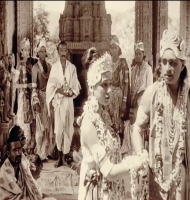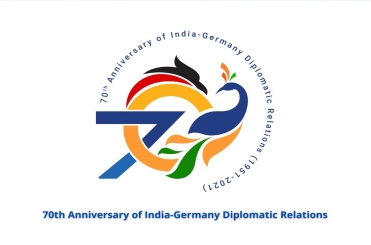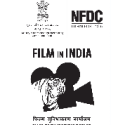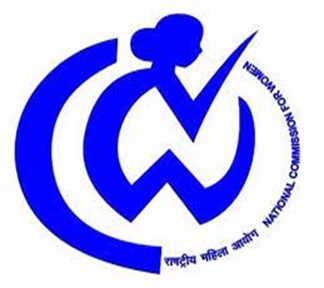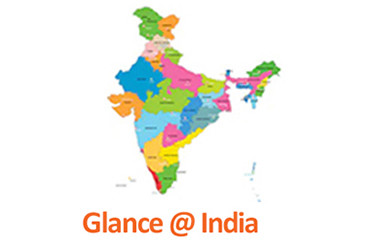|
The Light of Asia was a unique collaboration which was enjoyed by it’s patron in India, the Maharaja of Jaipur, as well as by the Royal House of Windsor in London. The 28-year-old Indian solicitor Himansu Rai came to Munich in search of partners for series of films on Indian themes. The Germans were to provide equipment, camera crew and the director, Franz Osten; Rai would provide the script, the actors, locations and all the capital necessary. On 26 February 1925, Osten and Rai, together with their cameramen, Willi Kiermeier and Josef Wirsching, boarded a ship for India. There Osten began to shoot his first Indian film, Prem Sanyas – Die Leuchte Asiens-The Light of Asia, the story of prince Gautama’s agonizing choice between his deep love for his wife, and a life of asceticism, leading to enlightenment.
Thanks to the new soundtrack composed by Willy Schwarz, the film is now supported with traditional Indian instruments like Vichitra Vina, Sarod, Bansuri, Sarangi, Santur, Tabla, etc.
Adding to the mix of Indian Classical and Folk melodies, Riccardo Castagnola’s talents as contemporary electronic composer are well-used for the dream and magical sequences,
As a director, Osten was a pioneer in both German and Indian films, directing over 50 films for the German EMELKA firm throughout the 20s, as well as a co-founder of Bombay Talkies, with such early Bollywood hits as Izzat, Prem Kahani, Nirmala, and Bhabhi to his credits.
Willy Schwarz, who himself will be present on the occasion, has been a professional musician and composer since 1964. His long career has spanned the worlds of touring, theater, advertising, cabaret, liturgical, and of course concerts in many diverse musical styles. His forte has always been traditional music from around the world, and he sings in 16+ different languages. His original music for Broadway productions earned him several celebrated awards. His study of Hindustani Classical and Folk Music began in 1970, and he has taken ”taalim” from Pt. Ravi Shankar, Ustad Allarakha, and other masters. For the soundtrack of The Light of Asia, he has performed on the Vichitra Vina, Sarod, Sarangi, Bansuri, Santur, Tibetan Dramyan, Thai Khaen, Tabla, Udakka, Turkish Bear Drum, Bowed Psaltery, and various percussion instruments.
For ”The Light of Asia”, Riccardo Castagnola not only managed the entire sound production, he also created the music underscoring the dream sequence and other supernatural effects throughout the film.
…………………………………………………………………………………………………………………………………………………………
Die Leuchte Asiens ist die erste Koproduktion deutscher und indischer Filmschaffender und die erste internationale Koproduktion Indiens. Der Film erzählt das Leben des Buddha Gautama. Der in London lebende indische Rechtsanwalt und Philosoph Himansu Rai kam auf seiner Suche nach Partnern für einen indischen Filmdreh nach München, wo er Kontakt zu Franz Osten aufnahm. Dieser sah eine Chance, in der exotischen Umgebung mit Maharajas, Tigern und Urwäldern Filme zu drehen, die das deutsche Publikum faszinieren sollten. 1924 ging Osten mit den Emelka-Kameramännern Willi Kiermeier und Josef Wirsching sowie dem Regieassistenten nach Indien und drehte dort den Film, mit spezielle Erlaubnis von den Maharadja von Jaipur. Als Regisseur hat Osten sowohl in Deutschland (mehr als 50 Werk) und in Indien Filme gedreht, wo er zu den Pionieren des Bollywood-Kinos mit Erfolgen wie Prem Kahani, Izzat, und Bhabhi gehört.
Die Leuchte Asiens bekam nun einen Soundtrack, der eine authentische Begleitung zu dem Geschehen auf der Leinwand darstellt. Der Musiker Willy Schwarz spielte dafür eine Reihe traditioneller Instrumente wie Sarod, Vichitra Vina, Bansuri, Santur, Tabla und Murali. Die musikalischen Motive wurden in klassische indische "Ragas", sowie Volksmelodien gesetzt. Riccardo Castagnola nutzte seine Fähigkeiten als Komponist zeitgenössischer elektronischer Musik, um die Traumsequenzen und andere magische Szenen zu unterstreichen.
Willy Schwarz ist seit 1964 als Berufsmusiker und Komponist tätig. Seine lange Kariere umfasst Tournèen, Theater, Presse, Kabarett, Liturgische Musik, und natürlich Konzerte in vielfältigen Styles. Seine Betonung lag immer auf traditioneller Weltmusik, er singt in 16+ verschiedenen Sprachen. Für seine Musik zu Broadway-Shows ist er mit wichtigen Preisen ausgezeichnet worden. Er hat seine Studien von klassischer nordindischer und Volksmusik im Jahr 1970 begonnen und hat von Pandit Ravi Shankar, von Ustad Alla Rakha und anderen Meistern „Taalim“ (Unterricht) bekommen. Für den Sountrack zu „Die Leuchte Asiens“ hat er die folgenden Instrumente gespielt; Vichitra Vina, Sarod, Sarangi, Bansuri, Santur, Tibetanische Dramyan, Thai Khaen, Tabla, Udakka, Türkische Bärentrommel, Bogenpsalterium und verschiedene Perkussionsinstrumente.
Für „Die Leuchte Asiens“ hat Riccardo Castagnola nicht nur die ganze Tontechnik beherrscht; er hat auch die Musik zur Traumszene sowie zahlreiche anderen „außerirdische“ Effekte im ganzen Film komponiert.
|
Embassy of India
Tiergartenstr. 17
10785 Berlin
Bus 200 Tiergartenstraße
|

|
Free entry to all events for a maximum of 200 guests with valid Indian, German or other valid ID cards/passports having German stay permits. EU citizens may carry copies of their local registration certificate. Bags are not allowed. Information: 030-25795105
Freier Eintritt für maximal 200 Gäste mit gültigen indischen, deutschen oder anderen gültigen Personalausweisen/Reisepässen mit Aufenthaltsgenehmigung für Deutschland. Das Mitführen von Kopien ihrer örtlichen Anmeldebescheinigung ist für EU-Bürger notwendig. Taschen sind nicht erlaubt. Informationen: 030-25795105
|
|
















